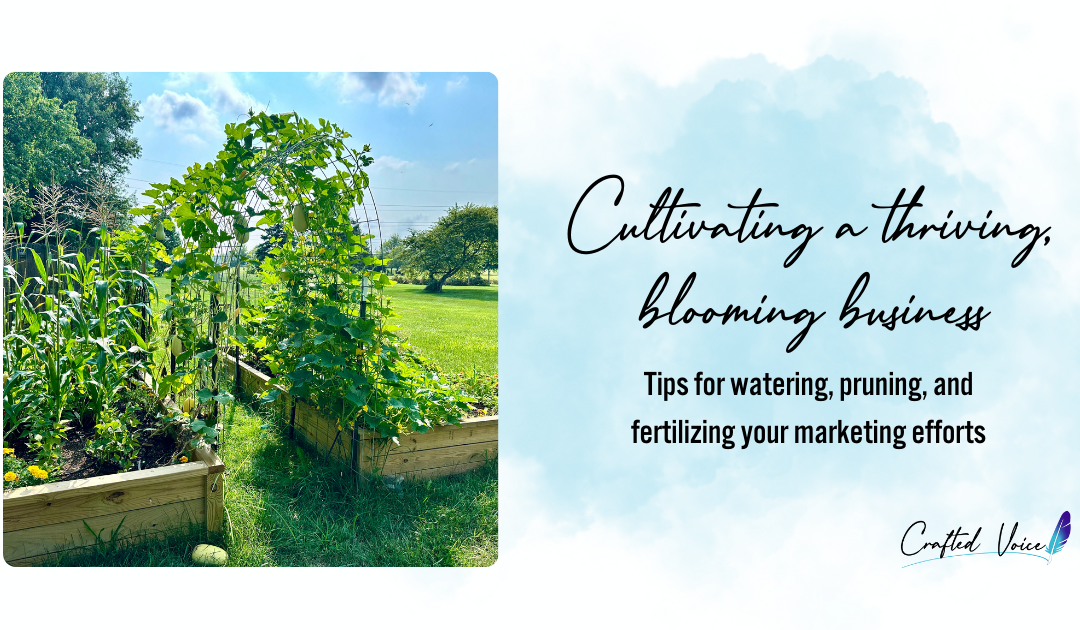I planted squash for the first time in my vegetable garden this summer, and the squash arches that my husband built make them a visual focal point in my side yard. The foliage climbs, the flowers bloom, and the fruit dangles. It’s beautiful! And then…I realized that squash vine borers laid eggs in the vines of my squash plants while I was on vacation. UGH! What was supposed to be a healthy, amazingly beautiful plant is now hanging on for dear life as the bugs do their damage to the base of the stem. I’m just hoping the fruit is able to keep growing long enough to be edible when it’s time for harvest!
As I spend time in my garden, I can’t help but think of the similarities between marketing for business owners and planting a garden. Just as a gardener carefully selects seeds, prepares the soil, and keeps those dang bugs away to ensure a bountiful harvest, business owners must implement effective marketing ideas to attract customers and cultivate growth. Utilizing a mix of digital and traditional methods can be the fertilizer you need to grow a thriving business.
With this analogy in mind, let’s explore a few promotional strategies in marketing to help you enhance your marketing efforts and reap the rewards.
What are the 5 steps of marketing strategies?
Before you plant a garden, you need to understand the strategy gardeners use to encourage plants to grow. Strategic elements include the appropriate amount of sunlight, nutrient-dense soil, spacing, companion planting, pest control, and more. In the same vein, understanding the key promotional strategies for small business is crucial for developing a robust marketing plan that encourages business growth.
Here are five essential steps to encourage a blooming, effective marketing strategy:
- Think of market research as your sunshine: Begin by gathering data about your target audience, market trends, and competitors. This information will shine light on your marketing efforts and help you make informed decisions about which steps are next.
- Define Your target audience to plant in the right spot: Clearly identify who your ideal customers are so that you aren’t planting your marketing campaigns in a spot that gets too much sunlight or where it can’t get the rain it needs. Understanding your target audience’s needs, preferences, and behaviors allows you to tailor your marketing messages effectively.
- Plant your marketing seeds by setting clear objectives: Establish specific, measurable, achievable, relevant, and time-bound (SMART) goals for your marketing campaigns. These objectives will help you stay focused and track your progress as your marketing campaigns begin to sprout.
- Make your marketing garden more effective by selecting marketing mix seeds: Planting a garden with only one vegetable is OK, but you are more likely to achieve success when you have a variety of healthy and beautiful veggies to choose from. Create a comprehensive marketing plan that includes various elements of the marketing mix—product, price, place, promotion, people, process, and physical evidence.
Water, implement and monitor: Execute your marketing strategies and continuously monitor their performance. Analyze the results, make necessary adjustments, and optimize your campaigns for better outcomes. If you notice one aspect of your campaign is a bit dry, change your game plan by giving it a little extra water and TLC. Neither gardening nor marketing should ever be a set it and forget activity.

What are 5 key marketing strategies?
In a vegetable garden, different vegetables require different care. For example, cucumbers need less water than tomatoes. Peppers need the perfect mix of nutrient-dense soil and water while zucchinis can grow without much care at all. To ensure your marketing efforts are effective, you need to focus on the promotion strategy in a marketing mix, caring for each campaign strategy a bit differently.
Consider these five key marketing strategies that can drive success for small businesses with the proper care:
- Content Marketing: Creating valuable, relevant content helps attract and engage your target audience. Blog posts, videos, infographics, and social media updates can build brand awareness and trust.
- Social Media Marketing: Utilize platforms like Facebook, Instagram, Twitter, and LinkedIn to connect with your audience, share content, and promote your products or services. Engagement is key on social media.
- Email Marketing: Build an email list and send regular newsletters to keep your audience informed about new products, promotions, and company updates. Personalized emails can increase customer engagement and loyalty.
- Search Engine Optimization (SEO): Optimize your website and content to rank higher in search engine results. This increases your visibility and drives organic traffic to your site.
- Pay-Per-Click (PPC) Advertising: Invest in paid advertising campaigns on platforms like Google Ads and social media. PPC ads can generate immediate traffic and conversions, especially when targeting specific keywords and demographics.
Choosing the right strategy for your business goes back to defining your target audience and setting them up as your sun. Just like a sunflower follows the sun, so should your marketing strategy follow your target customer.
What are the 5 strategies of advertising?
Think of advertising as fertilizer for your marketing garden. Advertising is a critical component of any marketing plan and should be added at the appropriate times to your strategy to drive traffic and conversions.
Five effective advertising strategies to consider are:
- Print Advertising: Utilize newspapers, magazines, and brochures to reach a local audience. Print ads can be particularly effective for businesses targeting specific geographical areas.
- Broadcast Advertising: TV and radio commercials can reach a broad audience quickly. This method is ideal for creating brand awareness and reaching potential customers.
- Online Advertising: Digital ads on websites, social media, and search engines can target specific demographics and track performance metrics in real-time.
- Outdoor Advertising: Billboards, transit ads, and signage can capture the attention of passersby and reinforce brand recognition.
- Direct Mail: Sending physical mailers to potential customers can create a personal touch and encourage them to take action, such as visiting your store or website.
How does marketing strategy increase sales?
An effective marketing strategy to increase sales of your current product involves several key elements. A great marketing strategy drives brand awareness, uses storytelling to make your product relatable to their daily lives, showcases the value in your product, leverages customer reviews and testimonials, and shares sales offers. By providing a mix of storytelling, peer reviews, and sales, you are setting your product up to be the perfect solution to the problem your target audience is facing.
Grow A Healthy Marketing Garden
A well-tended garden requires ongoing care, just as successful marketing for business owners demands strategy, continuous effort, and attention. By understanding and applying the right promotional strategies in marketing, you can cultivate a thriving, blooming business. If you need help watering, pruning, and fertilizing your marketing efforts for a bountiful business harvest, schedule a free consultation with the team at Crafted Voice. We’d love to partner with you on marketing strategy and execution to reach your business goals.

